 There’s a plethora of choices that comes with setting up a new marine aquarium; these days the seemingly simple task of adding rock provides no break in the daunting decision making process. Boat, plane, aquacultured, maricultured, man-made, hybrid, ceramic… all prefixes to the word rock describing our options. Which is best? Why isn’t this preference consistent among aquarists? The great debate rages on. The truth is, both live rock and dry rock can lead to stunning aquariums.
There’s a plethora of choices that comes with setting up a new marine aquarium; these days the seemingly simple task of adding rock provides no break in the daunting decision making process. Boat, plane, aquacultured, maricultured, man-made, hybrid, ceramic… all prefixes to the word rock describing our options. Which is best? Why isn’t this preference consistent among aquarists? The great debate rages on. The truth is, both live rock and dry rock can lead to stunning aquariums.
Live Rock
Utilizing live rock in aquaria has been one of the key factors attributed to keeping a modern reef aquarium. The myriad of beneficial bacteria keeps the nitrogen cycle intact, and has the added benefit of introducing: detritivores, invertebrates, sponges, tunicates, coralline algae, desirable macro algae, corals, and more. The copious amount of life is a surefire way to jumpstart your aquarium.
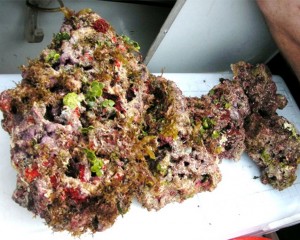
Maricultured live rock teeming with life. Credit: Ocean Life Direct, LLC
So, what’s not to love about live rock? Cost, quality, and invasive pests are the main complaints. Live rock in my area varies from $8-12 per pound. That adds up very quickly especially if building a sizeable aquarium. Quality of live rock is of the utmost importance when finding your source. History shows us there are two common ways to import ocean collected live rock, first being via boat (hence ‘boat rock’), the second by plane. Rock shipped by plane can be to your favorite retailer within 48 hours of being removed from the ocean, resulting in very little die off. As you can imagine, boxes of wet rock are heavy which leads to expensive freight, driving the cost up. ‘Boat rock’ takes weeks to get to the US resulting in lots of die off, but saves on freight. This rock is still good for beneficial bacteria introduction, although most other life forms will be lost after shipping.

Maricultured live rock. Credit: KP Aquatics
Removing rock from natural reefs has become illegal in many countries, and rightfully so. Fragging large coral colonies on a reef for aquarium import is one thing, frags grow back quickly in the wild, but rock does not. This is what spawned mariculture live rock. Some companies plant dry rock out on a leased patches of ocean allowing creatures to colonize it over several years. Since some of this rock is being grown right here in the US the price for quality rock right out of the ocean is kept reasonable.
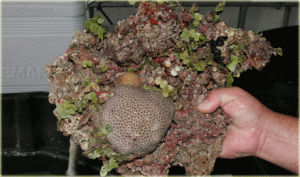
Coral and marco algae abound on this maricultured live rock. Credit: Gulf Live Rock
Invasive pests are another big concern when using live rock. Mantis shrimp, pistol shrimp, nudibranchs, flatworms and various polyclad worms are just a few of the inverts inevitably imported on some liverock. I even had a baby octopus fall into my hand when unpacking a live rock shipment years ago. Some of the aforementioned critters are very desireable in reef aquaria, others not so much. It can be argued that the undesirables can be starved out or predated upon, but for some the risk is not worth the reward.
Dry Rock
Dry rock has been in the hobby since its inception but is now used on a much larger scale. The rise of bottled beneficial bacteria was a big push for many to give it a whorl. Dry rock is offered in just as many shapes and sizes as live rock at a much lower cost, and guaranteed pest free. Since dry rock is, well… dry, the shipping cost is greatly reduced. Transit time doesn’t matter making ground transportation the standard option, and lacking water weight it comes in much lighter loads. Dry rock is generally easier to aquascape with since you can epoxy or cement pieces together without worry of killing organisms. Most dry rock is mined from quarries leased by dry rock suppliers. The rock is cleaned thoroughly and shipped off to hobbyists or local fish stores.

Dry rock offered by Marco Rocks. Credit: Marco Rocks
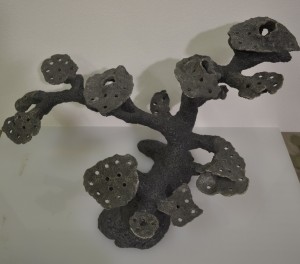
Ceramic structure offered from Alternative Reef. Credit: Alternative Reef

Full use of Korallenwelt ceramic. Credit: cheezyreef.weebly.com
Another aquascaping option which has garnished more attention in Europe over the years is ceramic rock structures. I categorize this with dry rock, although cost of ceramic structures are generally priced high, comparatively. Of course these are offered in a dramatic array of shapes and sizes, many of which could not be accomplished otherwise. Full back wall inserts, overflow, and pump covers are commonplace in the world of ceramics lending the ability to hide all equipment from plainsight.
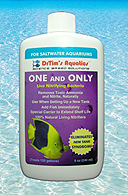
Dr. Tim’s bottled beneficial bacteria. Credit: Dr. Tim’s Aquatics
Obviously dry rock houses no beneficial bacteria initially, however once submerged beneficial bacteria will quickly colonize. This process can be jump started with bottled beneficial bacteria now offered by a dozen or more manufacturers. Some people choose to add small pieces of live rock to help diversify beneficial bacteria strains and jumpstart coralline colonization.

Hitchhiker Mithraculus crab found in a reef started with dry rock. Credit: Austin Lefevre
I would like to point out that even with the most diligent care you’re bound to wind up with pests in aquaria. The photo above is one of several first hand experiences I’ve had to prove this. As I was leaving my office one night I took a last glance at the reef and noted something odd on the urchin. It appeared to be a crab from the Mithraculus genus; the only invertebrate besides coral I added to this aquarium was the urchin, and the aquarium was started with 100% dry rock. Somehow the [at the time] tiny crab made it’s way through several dips and scrubs of the coral it hitchhiked in on, grew up in the modest 70 gallon display aquarium, and died.
A piece of valonia will sneak in on a coral skeleton. An aiptasia anemone will hide out in a crevice of a frag plug. Small patches of flatworm eggs on coral can be very difficult to spot and might sneak their way into your reef. Don’t think just because you’ve opted for dry rock that you’re in the clear.
Hybrid Rock
Several other companies now offer what I call hybrid rock. This rock is manmade, dyed, and generally given time to colonize bacteria in saltwater. Dyeing gives the rock a more natural appearance in order to not resemble a hunk of cement; some even dye patches of coralline algae. Walt Smith International places man made rock back into the ocean which gives ample time for other creatures such as sponges, tunicates, and corals to adhere. Real Reef uses large greenhouses inland providing light in order to grow live rock which avoids any impact on the ocean; something maricultured rock cannot claim. Another choice emerged last year from the familiar faces at Carib Sea, dubbed Life Rock. This rock is dyed as is the others, however kept completely dry. They coat the rock with beneficial bacteria microbes that come to life once submerged.
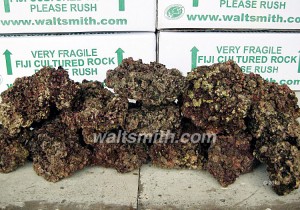
Walt Smith cultured live rock. Credit: Walt Smith Int., Ltd.

Sample of Real Reef rock. Credit: Real Reef

Real Reef Greenhouse. Credit: Real Reef
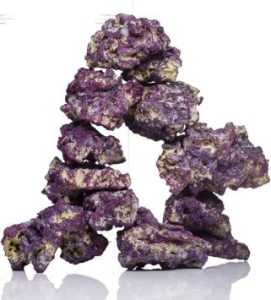
Carib Sea “Life Rock”. Credit: Carib Sea
Hybrid rock is an exciting new avenue to explore when it comes time to source your live rock. Be sure to research choices carefully as they are not all created equal. Some will come at a much lower price point, but may be missing components that help maintain alkalinity, or take considerably longer to establish a cycle in a new aquarium.
In conclusion, there is no right answer. As with many facets of the reefkeeping hobby everyone will have their opinion on the subject. The bottom line is with patience and proper husbandry all of the aforementioned choices can lead to a stunning reef.








0 Comments